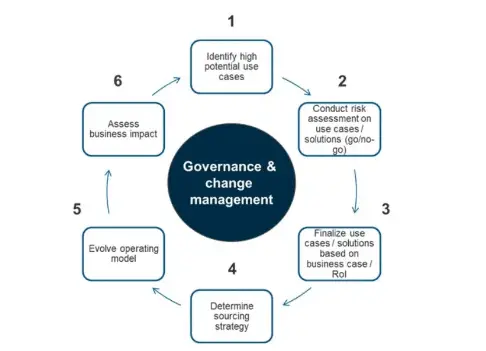🔐 Managing Execution Risks in Using Generative AI for Business

As business leaders, we’re on the verge of a technological revolution with generative AI, a tool that promises to transform our operations. However, plunging into this breakthrough is not without risks. Here’s an overview of the threats that require our attention:
🛡️ Data Security: Generative AI systems demand huge data inputs, which raises concerns about cybersecurity and privacy. Without strong safeguards, these advances may unintentionally jeopardize our company’s integrity and consumer trust.
🤖 Consistency and Accuracy: As generative AI matures, human guidance is necessary for interpreting its outputs. The uncertainty around the outcomes adds to the reluctance to employ it in day-to-day operations.
Accountability: AI-driven judgments require human oversight. While AI can provide suggestions, humans must remain the final arbiters, ensuring ethical standards and precision.
⚖️ Bias and Fairness: AI output is only as unbiased as its input. Collectively, these risks can harm an enterprise’s performance by eroding its competitive advantage and inflicting harm to its brand or reputation.
🌱 Sustainability: As we grow generative AI, we should be mindful of its carbon footprint. It is critical to strike a balance between innovation and our commitment to environmental sustainability.
To address these problems, a staged and deliberate strategy is required. This should include:
- Carefully choose AI use cases (examples).
- Conduct thorough risk assessments.
- Partnering with the proper AI suppliers.
- Adapting our operations to new technology.
5) Implementing effective governance and management processes. and
6) Continuous performance evaluations.
We can exploit the power of generative AI without jeopardizing our principles or our stakeholders’ trust if we adopt a responsible, ethical, and rigorous approach.
🔗 Partner with NeuralPit to enhance your business and employees using AI applications.
🛍️ Experience the latest AI technologies on the NeuralPit platform today!
What is NeuralPit?
NeuralPit enables businesses to accelerate innovation and productivity by easily integrating AI solutions into operations.
NeuralPit Platform provides AI Assistants for a variety of corporate areas, including consulting and business improvement, human resources, procurement and supply chain, finance, and operations. This allows businesses and professions to be more efficient and productive. As a compelling and cost-effective alternative to Microsoft Copilot and OpenAI, NeuralPit offers considerable benefits, particularly for small firms and professional teams, at significantly cheaper prices.
Teams can interact and co-innovate within and across business functions using a single NeuralPit Platform.
NeuralPit AI Assistants and its primary characteristics include:
○ AI Assistants for Consulting and Business Improvement: They extract insights from papers and data, as well as generate and visualize suggestions.
AI Assistants for Marketing and Sales help acquire market and competitor insights from websites and YouTube videos, analyze data, visualize information, create tailored marketing materials, and share them across platforms.
○ AI Assistants for HR Management: They assist with hiring and onboarding. This includes creating job advertisements, distributing them via email, Facebook, and other channels, and developing customized interview questions. They also provide interactive learning tools and HR performance analysis.
○ AI Assistants for Procurement and Supply Chain: They help evaluate vendor offers, analyze contracts, conduct supply chain analytics, and create commercial and negotiating strategies.
○ AI Assistants for Finance: They analyze financial data and provide insights from annual reports.
The NeuralPit platform enables teams to work on projects while effortlessly uploading and analyzing data in a variety of forms, including PDF, DOCX, Excel, CSV, video, audio, website URLs, and YouTube links. Team members may get insights, brainstorm ideas, view and engage with data at any time and from any location, as well as produce and share content across several platforms.
